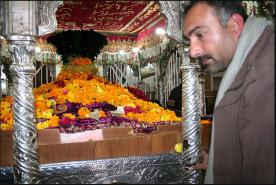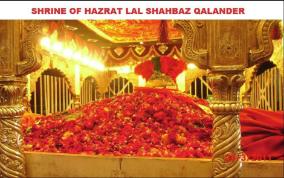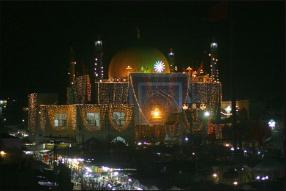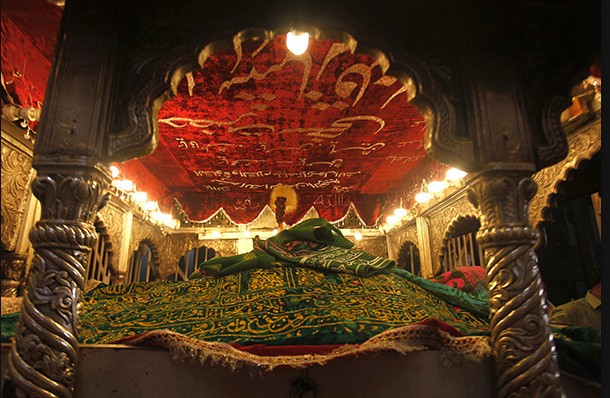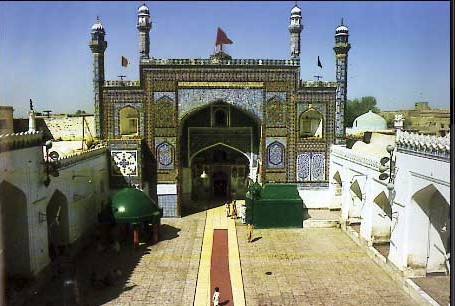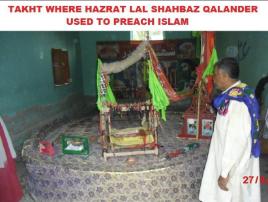
Ho Lal meri path rakhiyo bhala jhoole laalan
Sindhri da sehwan da sakhi shahbaz kalandar
Dama dam mast kalandar, sakhi shahbaz kalandar,
Ali dam dam de andar
Ho laal meri, ho laal meri
Char charag tere balan hamesha
Ho char charag tere balan hamesha
Panjwan balan aai aan bhala jhoolay lalan
Ho panjwan balan aai aan bhala jhoolay lalan
Sindhri da, sehwan da sakhi shahbaz kalandar
Dama dam mast kalandar, sakhi shahbaz kalandar
Ali dam dam de andar
Ho laal meri, ho laal meri
Ucha roza peera tera
Ho ucha roza peera tera
Heth wagay darya bhala jhoolay lalan
Ho heth wagay darya bhala jhoolay lalan
Sindhri da, sehwan da sakhi shahbaz kalandar
Dama dam mast kalandar, sakhi shahbaz kalandar
Ali dam dam de andar
Ho laal meri, ho laal meri
Maanvan noon peera bachray daina ain
Bhainan noon daina ain veer mala jhoolay lalan
Ho bhainan noon daina ain veer mala jhoolay lalan
Sindhri da, sehwan da sakhi shahbaz kalandar
Dama dam mast kalandar, sakhi shahbaz kalandar
Ali dam dam de andar
Ho laal meri, ho laal meri
"O the red robed, may I always have your benign protection, Jhulelal (as he was affectionately called). O master, friend and Sire of Sindh and Sehwan. The red robed God-intoxicated Qalandar, The Lord in every breath of mine, glory be to you.
Your shrine is always lighted with four lamps, And here I come to light a fifth lamp in your honor. Here I come with fifth O master, friend and Sire of Sindh and Sehwan (or Serwan), The red robed God-intoxicated Qalandar, The Lord in every breath of mine, glory be to you.
Let your heroic name ring out in Hind & Sindh (or lets the gongs bell loud), Let the gong ring loud for your glory day and night by the people (ghadiyaal - watchman, symbolism of night).
O Lord, may you prevail everytime, everywhere, I pray of your well being, In the name of Ali, I pray to you to help my boat cross in safety (in the river of life). |
Hazrat Lal Shahbaz Qalandar (1177-1274), a Sayed Sufi saint, philosopher, poet, and qalandar. Born Syed Hussain Shah, he belonged to the Suhrawardiyya order of Sufis. He preached religious tolerance among Muslims and Hindus. Thousands of pilgrims visit his shrine every year, especially at the occasion of his Urs.
Life
Shahbaz Qalandar (Syed Usman Marwandi) was born in Marwand, Afghanistan to a dervish, Syed Ibrahim Kabiruddin whose ancestors migrated from Baghdad and settled down in Mashhad, a center of learning and civilization, before migrating again to Marwand.
A contemporary of Baha-ud-din Zakariya, Fariduddin Ganjshakar, Syed Jalaluddin Bukhari Surkh-posh of Uchch, Shams Tabrizi, Mehre Ali Shah Mast and Rumi, he travelled around the Muslim world settled in Sehwan (Sindh, Pakistan) and was buried there.
His dedication to the knowledge of various religious disciplines enabled him to eventually become a profound scholar. During his lifetime, he witnessed the Ghaznavid and Ghurids rules in South Asia. He became fluent in many languages including Persian, Turkish, Arabic, Sindhi and Sanskrit. His mysticism attracted people from all religions. He was called Lal (red) after his usual red attire, Shahbaz due to his noble and divine spirit, and Qalandar for his Sufi affilitation. Hindus regarded him as the incarnation of Bhrithari. Lal Shahbaz lived a celibate life.
Evidence shows that Shahbaz Qalander was in Sindh before 1196, when he met Pir Haji Ismail Panhwar of Paat; it is believed he entered Sehwan in 1251. Shahbaz Qalander established his Khanqah in Sehwan and started teaching in Fuqhai Islam Madarrsah; during this period he wrote his treatises Mizna-e-Sart, Kism-e-Doyum, Aqd and Zubdah.
In poetry and prose
A qawwal sung by Abida Parveen and many others, "Lal Meri Pat Rakhiyo ..." is in honour of Shahbaz Qalandar, as is one sung in various versions by Nusrat Fateh Ali Khan and the Sabri Brothers, "Mast Qalandar".
This famous mystic often quoted the teachings of Maulana Jalal ad-Din Rumi. A book detailing his life is called "Solomon's Ring" by Gul Hasan.
Legends and Stories
On his way from Baluchistan to Sindh, he also stayed in present day Karachi's Manghopir area for muraqba (meditation), and it is said that Manghopir's natural warm fountain is a miracle of Lal Shahbaz Qalandar. That warm fountain started to flow from beneath the hill, on which Lal Shahbaz sat for muraqba (meditation). After passing hundreds of years, that warm fountain is still flowing continuously and is said to have miraculous healing power especially for asthma patients.
In Multan, Lal Shahbaz met Bahauddin Zachariah Multani of the Suhurwardiya order, Baba Farid Ganjshakar of Chishtiya order, and Makhdoom Jahanian Surkh Bukhari. The attachment was so cordial and spiritual that their friendship became legendary. They were known as Chahar Yar (Persian = four friends). According to some historians, the four friends visited various parts of Sindh and Punjab, in present day Pakistan.
Many saints of Sindh, including Shah Abdul Latif Bhitai, Makhdoom Bilawal and Sachal Sarmast, were devout followers of Lal Shahbaz Qalandar.
It is also believed that he turned into a falcon to pick up his friend Fariduddin Ganjshakar from the gallows. The legend goes that the incumbent fakirs in Sehwan sent him a bowl of milk filled to the brim, indicating that there was no room for anything more. But surprisingly, he returned the bowl with a beautiful flower floating on the top. This legend spread far and wide by the time of his death in 1274, after living a good span of 97 years.
Murshad/Sheik:
As it has been stated in the biography section, Lal Shabaz Qalandar (RA) was originally from Marwand Shareef; that is now in part of Afghanistan , near the border of Iran . However, we couldn't find ample material in the course of Lal Shahbaz qalandar's (R.A.) spiritual journey to Sehwan Sharif. However, we can identify from history, that he visited several places in Indian subcontinent, parts of Iran , Iraq and Hijaz ( Mecca and Madina ). Many historians believe that he paid a holy visit at the Shrine of Hazrat Imam Ali Reza (AS) the son of Hazrat Imam Musa-e-Kazim (AS). He performed pilgrimage in Mecca and visited Medina Munawwara: the holy shrine of Holy Prophet's (SAW). During this course he visited Karbala Mualla, Hazrat Holy Imam Hussain (AS)'s holy shrine and came to Baghdad Shareef (current capital of Iraq ); and met Hazrat Ibrahim(R.A) by whom he took Baiat (Reference). In other words Hazrat Ibrahim R.A)became his Shaikh. By his spiritual guidance Lal Saeen came to Sindh, spread the message of love, equality and truth; and met several saints of that time. One thing we forgot to mention is his companion from Baghdad was Hazrat Ali Sarmast (RA), a holy saint whose shrine is in Sehwan Sharif besides the shrine of Hazrat Lal Saeen (R.A). He accompanied him during the holy journey and in every step served him with devotion.
Khalifa
Hazrat Lal Shahbaz Qalandar (Q) bestowed khilafat to Hazrat Shaikh Ali Zowalqi Par Parwaz (Q) and he after him the mantel of Khilafat went in the hands of another Qalandar who abdicated throne in the path of Haq Hazrat Syed -o-Saddat Pir Nathar Tabl-e-Aalam Dhul Samadar (Q) of Trichy and he spread the silsila in India.
Hazrat Lal Shahbaz Qalandar (Q) is the jadd (founder) of Jalali silsila of Fuqra and the chief presidency [Sadar Chowk] of this silsila in India is Penukonda in the aastana of Qutubul Awliya Hazrat Khwaja Baba Fakhruddin Mujarrad Qalandar-e-Barhaq (Q.S)
Shrine
The shrine around his tomb, built in 1356, gives a dazzling look with its Sindhi kashi tiles, mirror work and one gold-plated door - donated by the late Shah of Iran, and installed by the late Prime Minister Zulfikar Ali Bhutto. The inner sanctum is about 100 yards square with the silver canopied grave in the middle. On one side of the marble floor is a row of about 12-inch-high (300 mm) folding wooden stands on which are set copies of Quran for devotees to read. On the other side, beside a bundle of burning agarbattis (joss sticks), are rows of diyas (small oil lamps) lighted by devotees.
Urs
His annual Urs (death anniversary celebration) is held on the 18 Sha'aban - the eighth month of the Muslim lunar calendar. Thousands of devotees flock to the tomb while every Thursday their number stands multiplied especially at the time of his Urs being a carnival as well a religious festival and celebrated every year. Sehwan springs to life and becomes the focal point of more than half a million pilgrims from all over Pakistan. On each morning of the three day feast, the narrow lanes of Sewhan are packed to capacity as thousands and thousands of pilgrims, fakirs and devotees make their way to the shrine to commune with the saint, offer their tributes and make a wish. Most of the people present garlands and a green chadar (a cloth used to cover a tomb) with Quranic inscriptions in silver or gold threads. Humming of verses, singing and dancing in praise of the saint continues till late at night. A devotional dance known as dhamal, being a frenzied and ecstatic swirl of the head and body, is a special ritual that is performed at the rhythmic beat of the [dhol] (a big barrel-shaped drum), some of them being of giant size and placed in the courtyard of the shrine. Bells, gongs, cymbals and horns make a thunderous din, and the dervishes, clad in long robes, beads, bracelets and colored head-bands whirl faster and faster in a hypnotic trance, until with a final deafening scream they run wildly through the doors of the shrine to the courtyard beyond.
CLICK THE THUMBNAILS FOR LARGER IMAGE
|
|
